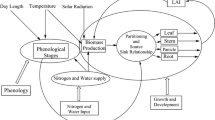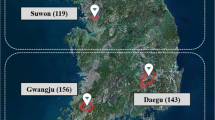Abstract
Temperature and CO2 are the two most important climate parameters that affect crop yield directly. In this study, the impact of these two parameters on the productivity of peanut and rice under the sub-humid and sub-tropical condition of Eastern India were assessed using experimental data and the DSSAT v4.5 CROPGRO-Peanut and CERES-Rice model. Experimental results of peanut and rice with four sowing dates of each were used as the baseline scenarios. The future weather data from the CSIRO-Mk3–6.0 model for RCP 4.5 and 8.5 was used to the peanut and rice crop model to simulate the yield using future weather data for the periods 2020, 2050, and 2080, and change in yield was compared with the baseline (1980–2013) at Kharagpur, West Bengal, India. The results reveal that rising temperature has negative effect on the growth and developmental phases of crop, and it brings early flowering. Concurrently, increase in temperature causes reduction of crop yield due to pollen sterility and poor pollen growth during reproductive growth stage. The CO2 concentrations used in the model, as projected by IPCC, were 390, 420, 530, and 650 ppm for the years 1980–2013 (baseline), 2020, 2050, and 2080, respectively. However, simulation was made using the model for percent change in mean temperature of 3.36 °C for 2020, 7.59 °C for 2050, and 10.4 °C for 2080. The model simulation reveals that elevated CO2 concentration of 420, 530 and 650 ppm showed gradual increase in the grain yield and biomass yield with shifting in sowing dates for peanut crop. On the other hand, for rice crop, though the crop yield increases gradually, the total biomass yield would reduce in future climate change scenario.
















Similar content being viewed by others
References
Aggarwal PK (2008) Global climate change and Indian agriculture: impacts, adaptation and mitigation. Indian J Agric Sci 78(10):911–919
Agricultural Statistics at a glance (2012) Department of Agriculture. Cooperation & Farmers Welfare, Directorate of Economics and Statistics, Ministry of Agriculture & Farmers Welfare, Government of India, pp 85–136
Attri SD, Rathore LS (2003) Simulation of impact of projected climate change on wheat in India. Int J Climatol 23:693–705
Bannayan M, Tojosoler CM, Garcia y Garcia A, Guerna LC, Hoogenboom G (2009) Interactive effects of elevated CO2 and temperature on growth and development of a short and long season peanut cultivar. Clim Chang 93:389–406
Boote KJ, Jones JW, Hoogenboom G (1988) Research and management applications of the ‘PNUTGRO' crop growth model, Proceedings of APRES: 20
Chattopadhyay N (2011) Climate change and food security in India. In: Lal R et al (eds) Climate change and food security in South Asia. Springer, Dordrecht, Heidelberg, New York, London, pp 229–250
Collier MA, Jeffrey SJ, Rotstayn LD, Wong KK, Dravitzki SM, Moseneder C, Hamalainen C, Syktus JI, Suppiah R, Antony J, El Zein A, Artif M (2011) The CSIROMk3.6.0 atmosphere-ocean GCM: participation inCMIP5 and data publication, International Congress on Modelling and Simulation – MODSIM 2011, Perth
Ghosh BC, Bhat R (1998) Environmental hazards of nitrogen loading in wetland rice fields. Environ Pollut 102(1):123–126
Gosain AK, Rao S, Mani A (2011) Hydrological modelling: a case study of the Koshi Himalayan Basin using SWAT. Soil Hydrology, Land Use and Agriculture, CAB International, Wallingford
Halder D, Panda RK (2014) Determination of appropriate sowing date and phosphorus fertilization strategy for peanut in eastern India. Afr J Agric Res 9(32):2475–2487
Halder D, Panda RK, Srivastava RK (2015a) Evapotranspiration based irrigation management strategy for peanut under water scarcity and climate variability conditions, International Symposium “New-Dimensions in Agrometeorology for Sustainable Agriculture”, at Pantnagar. Uttrakhand, India
Halder D, Panda RK, Srivastava RK (2015b) Impact of elevated temperature and CO2 on productivity of peanut in eastern India, ASABE 1st Climate Change Symposium: Adaptation and Mitigation Conference Proceedings, at Chicago
Halder D, Panda RK, Srivastava RK, Kheroar S, Shing SP (2016) Stochastic analysis of rainfall and its application in appropriate planning and management for eastern India agriculture. Water Policy 18:1155–1173
Hunt LA, Pararajasingham S, Jones JW, Hoogenboom G, Imamura DT, Ogoshi RM (1993) GENCALC: software to facilitate the use of crop models for analyzing field experiments. Agron J 85:1090–1094
Imai K (1988) Carbon dioxide and crop production. Jpn J Crop Sci 57:380–391
IPCC (2007) Technical summery. In: Climate change 2007: contribution of working group III to the fourth assessment report of the inter-governmental panel on climate change [Metz B, Davidson OR, Bosch PR, Dave R, Meyer LA (eds)]. Cambridge University Press, Cambridge and New York, pp 27–93
IPCC (2013) In: Stocker TF, Qin D, Plattner GK, Tignor M, Allen SK, Boschung J, Nauels A, Xia Y, Bex V, Midgley PM (eds) Summary for policymakers, in: climate change 2013: the physical science basis, contribution of working group I to the fifth assessment report of the intergovernmental panel on climate change. Cambridge University Press, Cambridge, United Kingdom and New York, pp 3–29
IPCC (2014) Synthesis report, in: climate change 2014: contribution of working groups I, II and III to the fifth assessment report of the intergovernmental panel on climate change [Core Writing Team, Pachauri RK, Meyer LA (eds.)], IPCC, Geneva, Switzerland, pp. 1-32
Jalota SK, Vashisht BB, Kaur H, Kaur S, Kaur P (2014) Location specific climate change scenario and its impact on rice and wheat in central Indian Punjab. Agric Syst 41:77–86
Jones PG, Thornton PK (2013) The potential impacts of climate change on maize production in Africa and Latin America in 2055. Glob Environ Chang 13:51–59
Kim HY, Horie T, Nakagawa H, Wada K (1996a) Effects of elevated CO2 concentration and high temperature on growth and yield of rice, I: the effect on development, dry matter production and some growth characteristics. Jpn J Crop Sci 65:634–643
Kim HY, Horie T, Nakagawa H, Wada K (1996b) Effects of elevated CO2 concentration and high temperature on growth and yield of rice, II: the effect on development, dry matter production and some growth characteristics. Jpn J Crop Sci 65:644–651
Krishnan P, Swain DK, Baskar C, Nayak SK, Dash RN (2007) Simulation studies on the effects of elevated CO2 and temperature on rice yield in eastern India. Agric Ecosyst Environ 122(2):233–242
Lal M, Nozawa T, Emori S, Harasawa H, Takahashi K, Kimoto M, Abe-Ouchi A, Nakajima T, Takemura T, Numaguti A (2001) Future climate change: implications for Indian summer monsoon and its variability. Curr Sci 81:1196–1207
Mangala Rai (2006) Rice research, ICAR News – a science and technology newsletter, July–September, pp 20
Morison JIL, Gifford RM (1983) Stomatal sensitivity to carbon dioxide and humidity: a comparison of two C3 and two C4 grasses. Plant Physiol 71:789–796
Morita S, Yonemaru J, Takanashi J (2005) Grain growth and endosperm cell size under high night temperatures in rice (Oryza sativa L.). Ann Bot 95(4):695–701
Ogden E, Innes JL (2008) Climate change adaptation and regional forest planning in southern Yukon, Canada. Mitig Adapt Strateg Glob Chang 13(8):833–861
Pathak H, Ladha JK, Aggarwal PK, Peng S, Das S, Singhm Y, Singh B, Kamra SK, Mishra B, Sastri ASRAS, Aggarwal HP, Das DK, Gulta RK (2003) Climate potential and on-farm yield trends of rice and wheat in the Indo-Gangetic plains. Field Crops Res 80:223–234
Peng S, Khush GS, Cassman KG (1994) Evolution of the new plant ideotype for increased yield potential. In: Proc. Workshop on rice yield potential in favorable environments. IRRI, Los Banos, pp 5–20
Peng SB, Huang JL, Sheehy JE, Laza RC, Visperas RM, Zhong X, Centeno GS, Khush GS, Cassaman KG (2004) Rice yield decline with higher night temperature from global warming. Proc Natl Acad Sci U S A 101:9971–9975
Prasad PVV, Boote KJ, Allen LH Jr, Thomas JMG (2003) Supra-optimal temperatures are detrimental to peanut (Arachis hypogaea L) reproductive processes and yield at ambient and elevated carbon dioxide. Glob Chang Biol 9:1775–1787
Prasad PVV, Vu JCV, Boote KJ, Allen LH Jr (2009) Enhancement of leaf photosynthesis and up regulation of Rubisco in the C4 sorghum plant at elevated growth carbon dioxide and temperature occur at early stages of leaf ontogeny. Funct Plant Biol 36:761–769
Rajwade YA, Swain DK, Tiwari KN, Mohanty UC, Goswami P (2015) Evaluation of field level adaptation measures under the climate change scenarios in rice based cropping system in India. Environ Process 2:669–687
Ramachandran A, Praveen D, Jaganathan R, RajaLakshmi D, Palanivelu K (2017) Spatiotemporal analysis of projected impacts of climate change on the major C3 and C4 crop yield under representative concentration pathway 4.5: insight from the coasts of Tamil Nadu, South India. PloS one 12(7):e0180706
Rosenzweig C, Hillel D (1998) Climate change and the global harvest: potential impacts of the greenhouse effect on agriculture. Oxford University Press, New York, p 324
Sakaigaichi T, Morita T, Abe J (2004) The problems on the root of the plant 127: form and function under high CO2 concentration condition of paddy field on rice root system. Agric Hort 79:287–292
Tubiello FN, Donatelli M, Rosenzweig C, Stockle CO (2000) Effects of climate change and elevated CO2 on cropping systems: model predictions at two Italian locations. Eur J Agron 13:179–189
Varshneya, M.C. (2009), Climate Change and its impact on Indian Agriculture. Date-2/27/12 http://abid-hussain.blogspot.in/2009/08/climate-change-and-its-impact-on indian
Vashisht BB, Mulla DJ, Jalota SK, Kaur S, Kaur H, Singh S (2013) Productivity of rainfed wheat as affected by climate change scenario in northeastern Punjab, India. Reg Environ Chang 13:989–998
Wallach D, Goffinet B (1987) Mean squared error of prediction in models for studying ecological and agronomic systems. Biometrics 43:561–573
Yoshida S (1981) Fundamental of Rice crop science. International Rice Research Institute, Los Baños, Laguna, p 269
Acknowledgments
The authors are thankful to the Agricultural and Food Engineering Department of Indian Institute of Technology Kharagpur, India, for providing the facilities to conduct experiments. The authors acknowledge the India Meteorological Department, India, for installing Automatic Weather Station at the Institute.
Author information
Authors and Affiliations
Corresponding author
Additional information
Publisher’s note
Springer Nature remains neutral with regard to jurisdictional claims in published maps and institutional affiliations.
Rights and permissions
About this article
Cite this article
Halder, D., Kheroar, S., Srivastava, R.K. et al. Assessment of future climate variability and potential adaptation strategies on yield of peanut and Kharif rice in eastern India. Theor Appl Climatol 140, 823–838 (2020). https://doi.org/10.1007/s00704-020-03123-5
Received:
Accepted:
Published:
Issue Date:
DOI: https://doi.org/10.1007/s00704-020-03123-5




